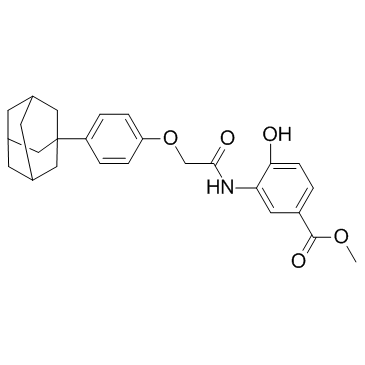LW6 (HIF-1α inhibitor) (Synonyms: Hypoxia-Inducible Factor1α Inhibitor) |
| Katalog-Nr.GC32724 |
LW6 (HIF-1α-Inhibitor) ist ein neuartiger HIF-1-Inhibitor mit einer IC50 von 4,4 μM. LW6 (HIF-1α-Inhibitor) reduziert die Proteinexpression von HIF-1α, ohne die Expression von HIF-1β zu beeinflussen.
Products are for research use only. Not for human use. We do not sell to patients.

Cas No.: 934593-90-5
Sample solution is provided at 25 µL, 10mM.
LW6 is a hypoxia-inducing factor 1(HIF) inhibitor, which effectively inhibits HIF-1α accumulation by degrading HIF-1α, but does not affect HIF-1A mRNA level during hypoxia. LW6 inhibits the expression of HIF and MDH2, with IC50 values of 4.4 and 6.3µM, respectively [1-2].
LW6(0.01-25µM ; 30 min) enhanced significantly the cellular accumulation of mitoxantrone(BCRP substrate)in MDCKII-BCRP cells (overexpressed BCRP)[3]. LW6 inhibited hypoxia-induced HIF1α expression at 20 mM in A549 cells, and at this concentration,LW6 induced hypoxia-selective apoptosis and decreased mitochondrial membrane potential[4]. LW6(40-160µM) inhibited proliferation and induced cell death in a dose-dependent manner In 6606PDA and MIA PaCa-2 cells[5]. LW6 (80µM)significantly inhibited migration,besides,LW6 reduced cell proliferation and induced cell death in a dose dependent manner[6]. LW6(30 µµ; 72 h) stimulates T cells to decrease HIF-1α levels[7]. LW6 inhibited T-cell clonal expansion in two-way mixed lymphocyte reaction (MLR) [8].
LW6(5 mg/kg;i.v/p.o) exhibited a small volume of distribution and a short terminal half-life. LW6 was slowly degraded in mouse liver microsomes and serum. About 54% or 44.8% of LW6 was available systemically as APA in the mouse after a single intravenous or oral administration, respectively[1].
References:
[1]. Lee K, Lee JH, et,al. (Aryloxyacetylamino)benzoic acid analogues: A new class of hypoxia-inducible factor-1 inhibitors. J Med Chem. 2007 Apr 5;50(7):1675-84. doi: 10.1021/jm0610292. Epub 2007 Mar 1. PMID: 17328532.
[2]. Naik R, Won M, et,al.Synthesis and structure-activity relationship study of chemical probes as hypoxia induced factor-1α/malate dehydrogenase 2 inhibitors. J Med Chem. 2014 Nov 26;57(22):9522-38. doi: 10.1021/jm501241g. Epub 2014 Nov 12. PMID: 25356789.
[3]. Song JG, Lee YS, et,al. Discovery of LW6 as a new potent inhibitor of breast cancer resistance protein. Cancer Chemother Pharmacol. 2016 Oct;78(4):735-44. doi: 10.1007/s00280-016-3127-2. Epub 2016 Aug 12. PMID: 27520631.
[4]. Sato M, Hirose K, et,al.LW6, a hypoxia-inducible factor 1 inhibitor, selectively induces apoptosis in hypoxic cells through depolarization of mitochondria in A549 human lung cancer cells. Mol Med Rep. 2015 Sep;12(3):3462-3468. doi: 10.3892/mmr.2015.3862. Epub 2015 May 27. PMID: 26017562; PMCID: PMC4526100.
[5]. Zhang X, Kumstel S, et,al. LW6 enhances chemosensitivity to gemcitabine and inhibits autophagic flux in pancreatic cancer. J Adv Res. 2019 Apr 24;20:9-21. doi: 10.1016/j.jare.2019.04.006. PMID: 31193017; PMCID: PMC6514270.
[6]. Zhang X, Liu P, et,al.Metformin and LW6 impairs pancreatic cancer cells and reduces nuclear localization of YAP1. J Cancer. 2020 Jan 1;11(2):479-487. doi: 10.7150/jca.33029. PMID: 31897243; PMCID: PMC6930432.
[7]. Eleftheriadis T, Pissas G, et,al. Malate dehydrogenase-2 inhibitor LW6 promotes metabolic adaptations and reduces proliferation and apoptosis in activated human T-cells. Exp Ther Med. 2015 Nov;10(5):1959-1966. doi: 10.3892/etm.2015.2763. Epub 2015 Sep 22. PMID: 26640580; PMCID: PMC4665222.
[8]. Eleftheriadis T, Pissas G, et,al.Comparison of the effect of the aerobic glycolysis inhibitor dichloroacetate and of the Krebs cycle inhibitor LW6 on cellular and humoral alloimmunity. Biomed Rep. 2017 Nov;7(5):439-444. doi: 10.3892/br.2017.980. Epub 2017 Sep 11. PMID: 29181155; PMCID: PMC5700391.
Average Rating: 5 (Based on Reviews and 12 reference(s) in Google Scholar.)
GLPBIO products are for RESEARCH USE ONLY. Please make sure your review or question is research based.
Required fields are marked with *




